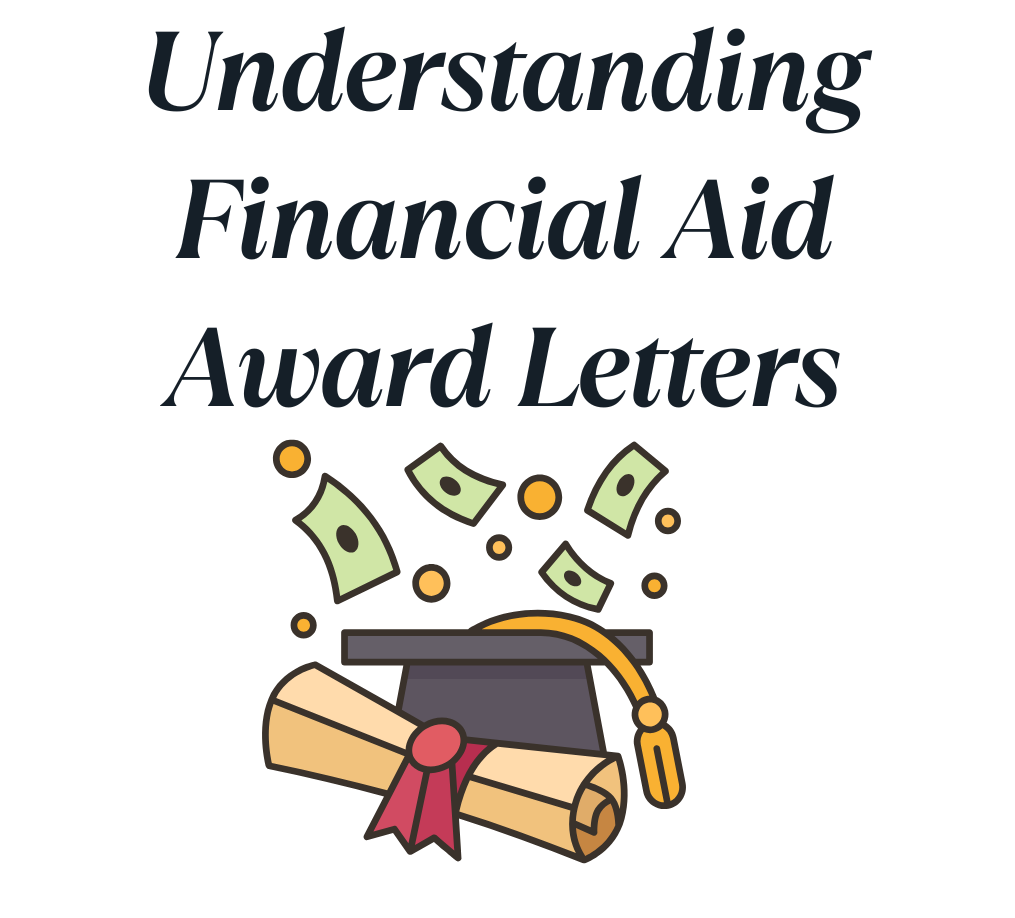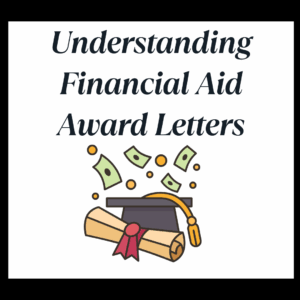This blog post is all about understanding your financial aid award letter so you can make a smart, informed college decision.
Disclaimer: I am not a financial professional. I’m not telling you what to do with your money or advising which college to attend. This post is for educational purposes only.
Understanding Financial Aid Award Letters
What is a Financial Aid Award Letter—and When Do You Get One?
A financial aid award letter is a document from a college or university that outlines the types and amounts of financial assistance you’re being offered to help cover your cost of attendance for the upcoming school year. This includes grants, scholarships, work-study, and loans—alongside an estimate of what it’ll cost to attend that school.
Even if you apply to multiple schools within the same system (like the UCs or CSUs), each college will send you its own unique award letter. That’s because aid can vary depending on each school’s cost of attendance, funding, and policies.
Award letters aren’t just one-time things—they’re updated every year because your financial aid eligibility can change. That’s why students are encouraged to fill out the FAFSA (or CADAA) every year.
In terms of timing:
- If you’re a first-year student (freshman or transfer), you’ll typically receive your financial aid award letter after you’re accepted but before the deadline to commit to a school.
- For continuing students, schools usually send award letters a few months before the next academic year starts, depending on when you submitted your FAFSA and how your school processes aid.
Personally, I think financial aid award letters are super important—they break down the real costs of college and give you clarity on how much support each school is offering.
Understanding Financial Aid Award Letters: What’s in a Financial Aid Award Letter?
Your financial aid award letter includes two main things:
- The financial aid you’re being offered
- An estimate of your cost of attendance for the upcoming school year
Types of Financial Aid You Might See
- Grants or Scholarships (Free money you don’t have to pay back)
-
Pell Grants – Federal aid based on financial need.
-
State Grants – Offered by your state (like Cal Grant); based on residency and financial need.
-
University Grants – Provided by your college; can be based on financial need, merit, or both.
-
University Scholarships – Awards from your college for merit, need, or other criteria.
-
Some are automatic (based on your GPA or application).
-
Others you may need to apply for separately (like departmental or donor-funded scholarships).
-
-
- Loans (Money you borrow and have to repay — usually with interest).Your award letter will list any federal loans offered to you, such as:
-
-
Subsidized Loans
-
Unsubsidized Loans
- Parent PLUS Loans
-
Want help understanding the difference?
👉 Check out my blog post: Student Loans Explained: What You Need to Know
- Work-Study (Money you earn through a part-time job)
-
-
- If you qualify for work-study, it means you’re eligible to get a part-time job on campus and earn money throughout the year. This money isn’t guaranteed — you’ll have to find a job and work to earn it.
-
-
Note: Some schools offer grants or scholarships that are only available to their own students (called institutional aid). That’s why even if you submit the same FAFSA, your award letters may look very different depending on the school.
What’s Included in the Estimated Cost of Attendance
- Tuition and fees
- Room and board (housing and meals)
- Transportation
- School supplies and materials
- Personal expenses
Most schools list tuition and fees as a set cost, but the other items are usually just estimates based on an average student’s experience. For example:
- Room and board depends on what housing you choose—whether you’re living in a standard dorm, an apartment, or commuting from home.
- School materials vary by class. I personally had courses where I didn’t have to buy any books, and others where I had to purchase multiple.
- Transportation is different for everyone. I didn’t have a car in college, so I used Uber or public transit. Others paid for gas, parking permits, or campus shuttle passes.
Net price
Net Price is the total cost of attendance minus any scholarships and grants (free money) — it’s what you’ll actually need to cover out of pocket or with loans, work-study, or other aid.
Sometimes the school with higher tuition ends up being cheaper through the Net Price.
When I got my award letters from both the CSUs and UCs, the UCs had higher tuition — but they also gave me more grants. I actually would’ve needed to take out loans if I had gone to a CSU. Always compare the net price, not just the sticker price.
Award letters give you a snapshot of how much college might cost and how much help the school is offering. It’s one of the most important tools when comparing schools—especially if you’re trying to make the smartest financial choice.
Every school structures their award letters a bit differently, so don’t hesitate to contact the financial aid office if you have questions about what’s being offered.
Understanding Financial Aid Award Letters: Financial Aid Appeal Letter
If your financial aid offer doesn’t fully cover your needs, you can submit an appeal to the school’s financial aid office. While appealing doesn’t guarantee more aid, it won’t hurt you to try — and sometimes it works.
Each university has its own process, but most schools will ask you to:
- Fill out an appeal form
- Submit a written explanation of your situation
- Possibly include documentation (like a change in family income, medical bills, or loss of a job)
Be honest about your situation, and don’t be afraid to ask. You never know what can change until you speak up.
I’m sharing this because when we fill out the FAFSA, it uses tax information from two years ago. For example, if you’re doing the 2026–2027 FAFSA, it will look at your 2024 taxes — but a lot can change in that time.
Maybe your family’s income dropped in 2025, or your financial situation changed. Or maybe you’re no longer considered a dependent — like if you got married, had a child, or meet other criteria to be considered independent.
These are all valid reasons to submit a financial aid appeal. Schools can’t guess your current situation — but they can reconsider your aid if you let them know what’s changed.
Current college students can also appeal their financial aid when they get their new award letter for the upcoming school year. If your situation has changed since your last FAFSA, it’s worth reaching out — you might qualify for more help.
If your appeal didn’t go how you hoped or your grants didn’t cover everything, don’t stress — there are still options.
You can always pick up a side hustle or start applying to outside scholarships (there’s way more out there than you think).
I have a full blog post on side hustles and a blog series on how I graduated debt-free from UCLA through scholarships where I shared all my tips and strategies.
If I could do it, so can you.
Disclaimer: I’m not telling you what to do with your money — this is for educational purposes only, based on what I’ve learned and experienced.
Understanding Financial Aid Award Letters: What to Do After You Get Your Award Letter
Once you’ve received your award letters from the colleges you were accepted to — and you’ve decided where to attend and submitted your Statement of Intent to Register (SIR) — or if you’re a continuing student who just got your award letter for the next academic year, the next step is to accept the aid you want to use.
As I mentioned earlier, financial aid can come in different forms:
- Free money – like scholarships and grants (you don’t have to pay this back)
- Earned money – like work-study (you earn it through a campus job)
- Borrowed money – like student loans (you’ll have to repay this later)
It’s up to you to accept only what you want — you don’t have to take everything offered.
Most students accept the free money first (scholarships and grants). Just make sure to:
- Check the eligibility requirements
- See if the award is renewable every year or one-time only
When it comes to work-study, I would accept it if I was eligible — it doesn’t guarantee a job, but many campus employers give priority to work-study students. If you don’t end up working, no worries — you just won’t earn that money.
Plus, a campus job is a great way to meet other students, the hours are usually more flexible around your class schedule, and it’s super convenient if you live in the dorms or close to campus.
As for loans, you can choose to accept all, some, or none of them. There are several types of loans, and it’s really important to understand what you’re signing up for. I wrote a blog post to break it all down:
👉 Student Loans Explained: What You Need to Know
Disclaimer: I can’t tell you whether or not to take out loans — that’s your decision.
But if you choose not to accept loans or other forms of aid, just remember: you’re responsible for covering any remaining balance (if there is one) out of pocket by the university’s payment deadline. Most schools offer payment plans, but you’ll need to arrange that directly with the financial aid or billing office.
And don’t worry — if you don’t accept the loan, you’re not responsible for paying it back. You only repay what you actually borrow.
Understanding Financial Aid Award Letters: Final Thoughts
Understanding your financial aid award letter is one of the most important steps in making a smart college decision. Whether you’re a first-year student or returning for another year, knowing what’s being offered—and what it really means—can help you avoid surprises later. If anything is confusing or doesn’t add up, don’t hesitate to contact your school’s financial aid office. They’re there to help you, and asking questions now can save you stress (and money) later. You deserve clarity, support, and confidence as you navigate college finances—so advocate for yourself and don’t be afraid to speak up.


